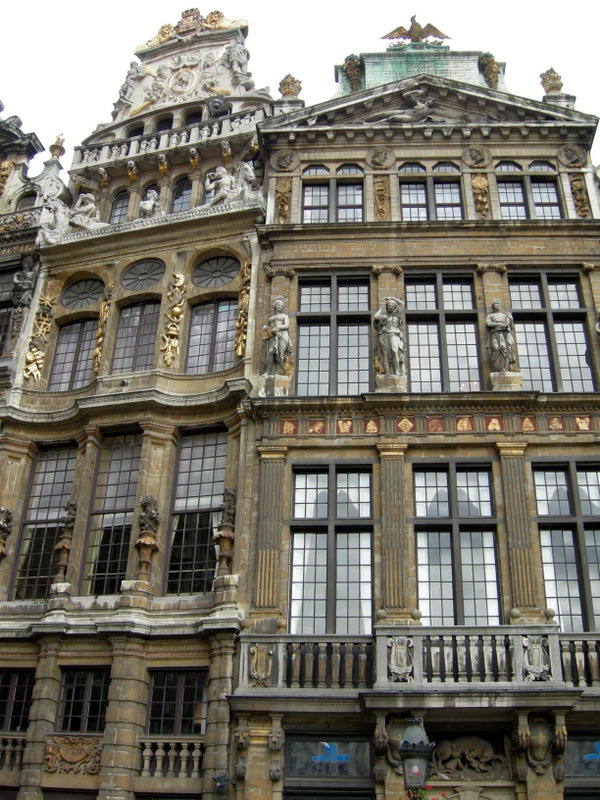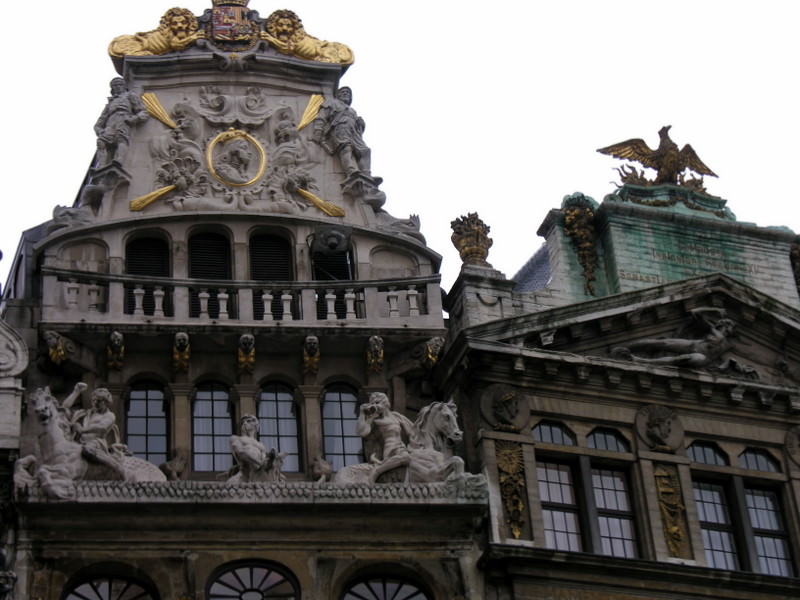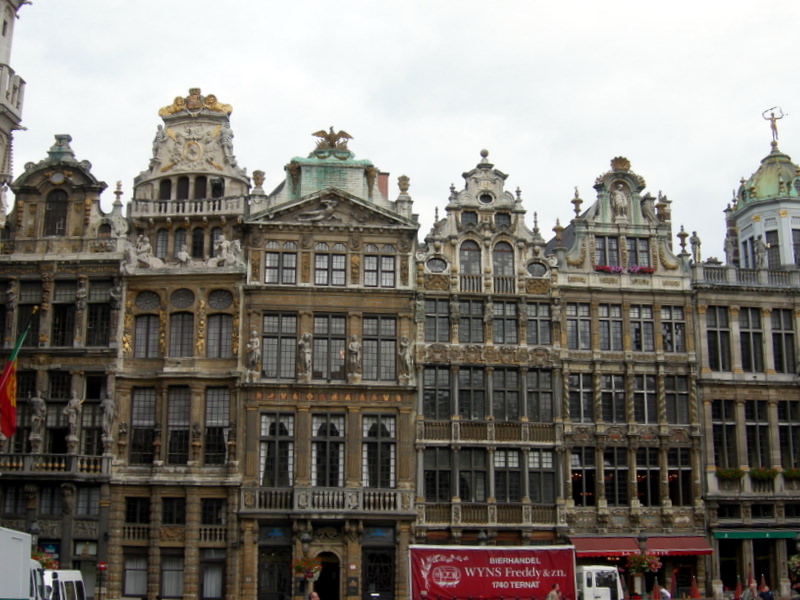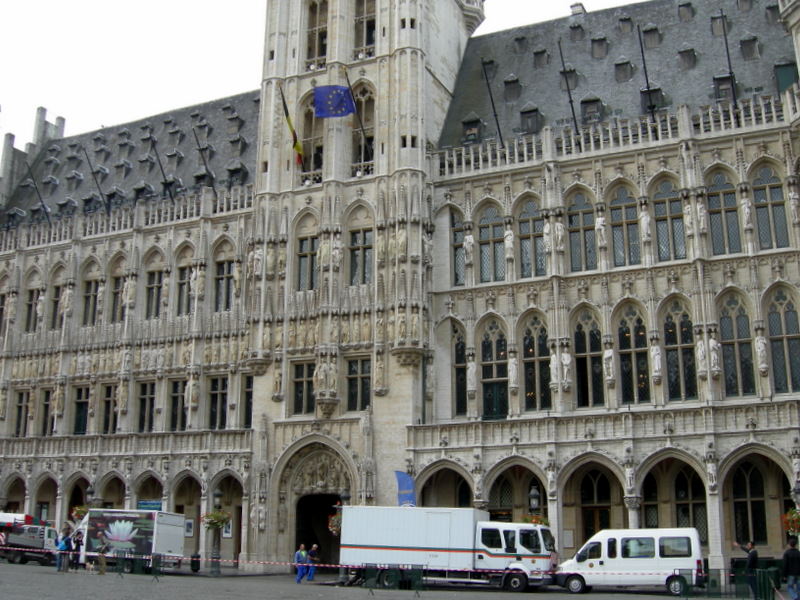Europe has many elaborately crafted medieval town squares, but none is as ornate or theatrical as the Grand Place in Brussels. The stunning 17th century neo-classical Flemish façades of the superbly restored guild houses on this cobblestone square tell about its days of glory when Brussels was one of Europe’s main centers of industry.
After walking through dark, narrow cobblestone alleys, you suddenly emerge on the large square at the Grand Place. Tall Gothic, Renaissance and Baroque facades of elaborately crafted guild houses tower above you on all four sides, immediately taking you back four centuries. You’re now looking at Europe’s most perfectly preserved and most picturesque medieval square.
Brussels thrived as a commerce center from 1100 on, and to accommodate the teeming markets and trader’s houses, the square was paved in the twelfth century over marshy ground. By the 13th century, tradesmen’s organizations like the drapers guild, established in 1282, were built at the Grand Place. Brussels’ humming markets attracted many more trade and merchants’ guilds. Neighboring streets were named after the food sold there; there’s still a Rue au Beurre (Butter Street) and Rue des Bouchers (Butcher’s Street) close by the Grand Place.
Guild houses formed the corporate headquarters for large groups of merchants and tradesmen in the Low Countries. Becoming so economically and politically powerful, their leaders met in them to discuss new rules and regulations within their own trade, even making recommendations to the city administration. As the guilds became involved in many wars ravaging Europe, they further increased their power and could command higher membership fees. And nowhere in Europe today will you find guild houses as perfectly preserved as those in Brussels’ Grand Place.
Through the adornments of gilded statues and elaborately carved symbols related to their trade, the influence of the guild houses is still evident today. Their power was so great that when their guild houses were completely destroyed by the French bombardment in 1695, they were rebuilt in stone within 5 years.

La Louve (the she-wolf) was the archer’s guild. On the bottom right, you can just make out the relief of Romulus and Remus being suckled by a she-wolf
The first building to catch your eye in the Grand Place is the massive 1459 medieval, sandstone Hotel de Ville (Town Hall). This Gothic masterpiece is 300 years older than the guild houses in the square, being the only building to survive the French cannonade. Its octagonal belfry spire towers 376 feet over Brussels, topped by a bronze statue of St. Michael crushing the devil beneath his feet. Over the massive wooden gateway are statues of prophets, priests, and long-gone dukes and duchesses.
The elaborate 15th century Gothic façade of the Maison du Roi opposite the Hotel de Ville, served as Charles V’s administrative offices. Before it was constructed, the site was a bread hall dating from the 13th century, where bakers set out their wares. Today it houses the Musee Communal with paintings by Breughel, and fine tapestries.
The Maison des Boulangers (Baker’s House, no.1-2), now a great restaurant called Le Roi D’Espagne (King of Spain), has a bust of St. Aubert, patron saint of bakers, on the first floor. Six statues on the balustrade represent the six ingredients of bread: energy, agriculture, wind, fire, water and prudence. Le Sac (no.4) is home to the furniture and cabinet-makers and coopers, with an emblem above the door of one worker holding a sack while someone removes something from it.

The Grand Place’s Guild houses are stunning. This is le Cornet, the Boatmen’s Guildhouse, shaped like the stern of a galleon.
La Louve (no.5) has a relief statue of Romulus and Remus being suckled by a wolf, hence its name (The She-Wolf) representing the archer’s guild. Atop this building is a golden phoenix rising from the sashes, signifying the rebirth of the Grand Place after the bombardment. The boatmen had their guildhall at Le Cornet, (The Horn, no.6) dating from 1434. Its façade is covered by nautical symbols. If you look up at the top level, you’ll see a perfect replica of the stern of a galleon. Next door is den Vos (The Fox, no.7), the mercer’s and haberdasher’s guildhall—look for the beautiful wooden statue of a fox above the entryway.

The southeast side of grand place is taken up entirely by the neo-classical Femish la Maison des ducs de Brabant, a group of 6 guildhouses.
Directly across from this row of guild houses you’ll see Le Cygne (The Swan) dating from 1720, which was the butcher’s headquarters. Today it fittingly houses an expensive restaurant. La Maison des Brasseurs (Brewer’s Guildhall, no.10) is the only building today that houses its original guild. It also houses a small brewer’s museum. The entire east side of the square is taken up by a magnificent wide, gold fronted monolith called the House of the Dukes of Brabant, that housed several guildhalls including millers, tanners, wagonmakers and carpenters.
Written by Roy Stevenson for EuropeUpClose.com




Jeana
Saturday 6th of August 2016
Excellent report. Looking forward to visiting Brussels.
Marissa_My Greece, My Travels blog
Saturday 26th of March 2016
It is a wonderful picturesque city indeed. I love that square.
Michelle
Friday 30th of November 2012
Wow so pretty!